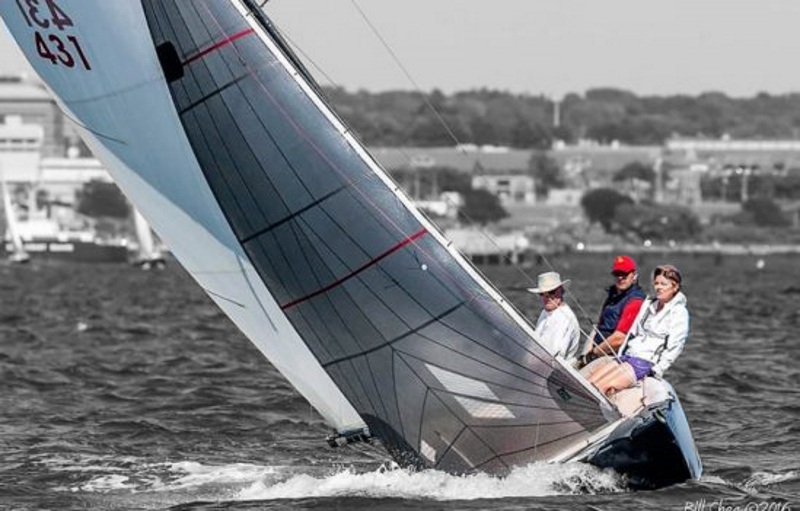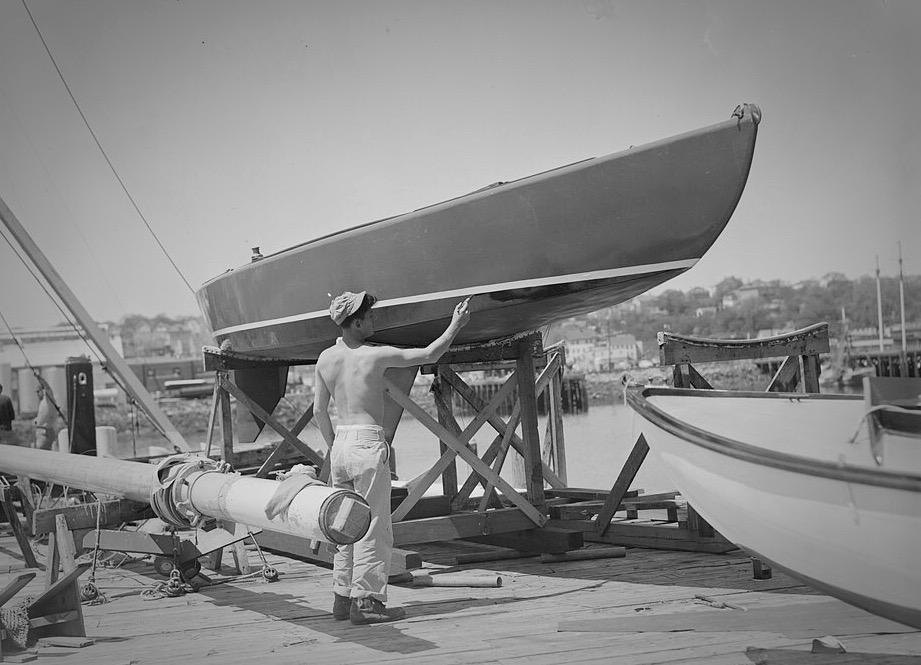
Sail Number: 210
Type: International 210
LOA: 29’10” / 9.09m – LOD: 29’10” / 9.09m – Beam: 5’10” / 1.77m – Draft: 3’10” / 1.16m – Ballast: 1,175 lbs / 532.97kg – Displacement: 2,300 lbs / 1043.26kg – Designed: C. Raymond Hunt – Sail Plan: Main, Jib, Spin Spinnaker: Conventional – Upwind sail area: 305 sq ft
Spinnaker sail area: – Hull material: Double Curvature 3/8 “Harborite” Plywood bent over laminated oak frames. – Crew: 3 – Original Contract Price: 1,275 – 1,500 w/o sails – In Current Production: Yes – Approximate number built: 462
Historical:
Kenneth D Rolt – My dad witnessed the events described below as a teenager; prior to crewing on 30 US40 during 1946-1947 for my grandfather and the boat owner George T. “Mike” Brady.
- Hunt built the prototype in 1940, and raced it. It became the 210 #1, the “Et Tu”.
- The Boston. Globe – August 21, 1940 – 1940 Race Results
- The Boston. Globe – September 1, 1941 – Article – Bad Risks Prove Good at Winthrop – Wins in Class 1 as 190 Craft Sail in Second Day of Regatta.
WW II delayed the further demonstration and development until after the war. A new boat was discussed and planned in late 1945, giving rise to the production demonstrator model in 1946, the 210 #2, which eventually became C.F. Adams’ “Harpoon”. My grandfather test drove this boat in the spring of 1946, preseason, because that same day the boat committee found it lacking during tests.
In short, the boat committee thought it was a performance dud after each member tested it. One of the committee suggested that my grandfather George Rolt try the boat. Rolt was a South Boston boat builder and well-known as a racer, and was in Marblehead that day tuning 30 US40 for the upcoming 1946 season of Thirty Square Meter Racing for Corinthian and Eastern YC events. He took the 210 out solo outside Marblehead Harbor and began legs downwind, and windward on both tacks. Satisfied with the observations, he returned to the dock. He asked that the boat be lifted by Graves. He pointed out the visible misalignment of the keel axis with the boat axis, something he was very familiar with from boat building. A well-built boat has no self-helm tendency if the boat is built straight. A poorly built boat will turn on its own, and therefore require helm corrections (and drag) to drive straight. He then suggested that the keel be loosened, realigned, and then retightened. That happened, followed by each committee member taking another turn at the helm. That solved the problem, the committee was very pleased with the boat, and the 1946 orders followed in turn. My grandfather didn’t get back into a 210 until 1948-1950 as guest skipper, after the 30s had moved to the Great Lakes. He was a regular with George O’Day and Cornelius (“Connie”) Wood in Wood’s 210, as the EYC representative for the Manhasset Bay Challenge Cup in 1951 and 1952, winning in 1951.
My dad is still amazed by having watched the 1946 Marblehead 210 demo, seeing the unhappy EYC, Corinthian and Boston YC committee members as they exited 210 #2. Then seeing the committee ask my grandfather to try it, and later solve it. My dad added one other tidbit to the story. The chief foreman at Graves (where the 210 had been built) was very unhappy at how the day unfolded, and that my grandfather found the keel-alignment fault (which Graves’ should have caught). Words were exchanged, but my grandfather had worked in the Boston Navy Yard during the war so he tried to be diplomatic in spite of the embarrassment of the Graves staff. “They asked me to look at the boat” and for him (expert skipper & boat builder) it wasn’t that hard to figure out.
The 210 was drawn by Fenwick Williams, under the guidance of C. Raymond Hunt. Designed to be a bigger drier boat than the 110s. Mr. Hunt built a prototype in 1941, which proved a race winner. World War II postponed all racing until 1946, whereby after keel alignment to hull number 2, was presented to the clubs of Massachusetts Bay for consideration as the selected boat for inter-club racing. The requirements of the clubs were that they wanted a new one design boat that was affordable, pleasant for day sailing as well as racing, a boat that will always be uniform so that it cannot be out-built. ‘Fourth a boat that is modern and can be kept so. At the next meeting, the selection committee announced that Ray Hunt’s proposed “210″ was more boat than any other that the clubs could find for the money, so they adopted it, and with it a new era in yachting was ushered in.
True to the 210s origins through good price, comfort, and exceptional racing abilities, the class took off with some of the sports top sailor’s campaigning boats throughout Massachusetts Bay. Over 60 boats were built at Graves Yacht Yard on Front Street, Marblehead (rigging. supplied by Merriman Bros. Inc.) for the 1946 Summer season. Soon fleets were formed throughout the Midwest, Maine, Hawaii and beyond.
Governed by strict one design class rules, to keep boat costs down, but allowing for nominal changes to keep up with the times, a successful concept for the development of the class, yet challenging at times.
The International 210 is currently in production at Shaw Yacht’s, Inc., 52 Oyster River Road, Thomaston, ME 04861, Phone: (207) 594-5035, Fax: (207) 594-5035

Comments
Kenneth D. Rolt – July 16, 2020
Hunt built the prototype in 1941, and raced it. It became the 210 #1, the “Et Tu”. WW II delayed the further demonstration and development until after the war. A new boat was discussed and planned in late 1945, giving rise to the production demonstrator model in 1946, the 210 #2, which eventually became C.F. Adams’ “Harpoon”. My grandfather test drove this boat in the spring of 1946, preseason, because that same day the boat committee found it lacking during tests. The 210 web site documents the efforts of the committee to scope out the boat in 1945, basically circa $1300 per boat using plywood (so lower construction costs), under 30 ft LOA, to promote widespread sales and therefore similarly wide interclub racing. It also mentions the demonstrator model in 1946 but does not describe the problem the boat had. In short, the boat committee thought it was a performance dud after each member tested it. One of the committee suggested that my grandfather George Rolt try the boat. Rolt was a South Boston boat builder and well-known as a racer, and was in Marblehead that day tuning 30 US40 for the upcoming 1946 season of Thirty Square Meter Racing for Corinthian and Eastern YC events. He took the 210 out solo outside Marblehead Harbor and began legs downwind, and windward on both tacks. Satisfied with the observations, he returned to the dock. He asked that the boat be lifted by Graves. He pointed out the visible misalignment of the keel axis with the boat axis, something he was very familiar with from boat building. A well-built boat has no self-helm tendency if the boat is built straight. A poorly built boat will turn on its own, and therefore require helm corrections (and drag) to drive straight. He then suggested that the keel be loosened, realigned, and then retightened. That happened, followed by each committee member taking another turn at the helm. That solved the problem, the committee was very pleased with the boat, and the 1946 orders followed in turn. My grandfather didn’t get back into a 210 until 1948-1950 as guest skipper, after the 30s had moved to the Great Lakes. He was a regular with George O’Day and Cornelius (“Connie”) Wood in Wood’s 210, as the EYC representative for the Manhasset Bay Challenge Cup in 1951 and 1952, winning in 1951.
My dad witnessed the events described above (as a teenager, prior to crewing on 30 US40 during 1946-1947 for my grandfather and the boat owner George T. “Mike” Brady). He recounted it for me. I later found the newspaper articles from 1941 and 1946 concerning Hunt’s 210s as described above if you want them. HTH.
Kenneth D. Rolt – August 18, 2020
Another update. Et Tu, Ray Hunt’s 210 prototype was actually built in 1940, as evidenced by the Aug 21 1940 race in New Bedford MA in the Cruising Class B. News clipping is forthcoming.

